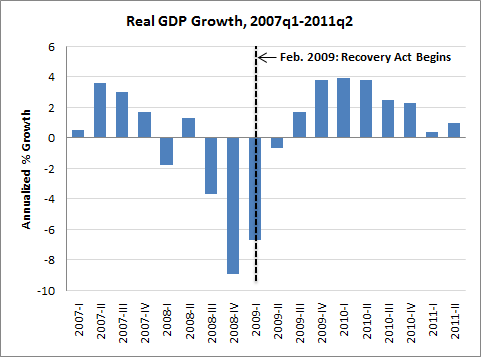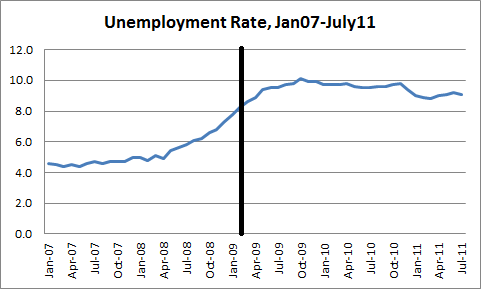So there I was, quietly working on a piece on the economic impact of the Recovery Act when I stumbled on a few simple graphs that I think tell a very compelling story.
It's an important story too, both in terms of looking backwards and forwards.
Republicans constantly ply the talking point "discredited stimulus" in the interest of blocking any similar ideas, like some of those I expect to hear come out of the president's jobs package. But the evidence shows otherwise. The evidence shows the stimulus (and other stimulative measures, including those of the Fed) worked, but ended too soon, before the private sector was ready to walk on its own. The evidence shows we need to do more of these sorts of policy interventions.
I know -- this ain't about the evidence. But I will never accept that condition and neither should anyone else. That's the way societies decline and I'd kind of like to avoid that.
The first graph shows the growth in real gross domestic product (GDP) from 2007 up until the last quarter. The next picture shows job growth over the same period in both the total job market and excluding government jobs, since the temporary influx of Census working in 2010 distorts the overall series for a few months.



Sources: GDP: BEA, Payrolls and unemployment, BLS
While these are very simple pictures of fundamental economic variables, and while there are always many moving parts influencing such trends, they a) present remarkably compelling evidence against the "failed stimulus" case, and b) show that we need to do more of these types of interventions.
When the bill was signed in February 2009, GDP growth was almost unprecedentedly negative -- down 9% in the previous quarter (2008q4). But as the figure reveals, the economy immediately between to contract less quickly, and growth turned positive by mid-2009. We see the same pattern in job growth, which also reversed course soon after passage, and broke zero -- net job growth -- in March of 2010 (the addition and subtraction of Census workers that year distort the picture somewhat, but they're not included in the private sector data, which present a clearer view of what happened).
Unemployment always lags growth by at least six months, but a few months after ARRA kicked in, it stopped growing.
But that's only half of what these simple graphs show. The other piece of information they yield is even more important. As the stimulus fades, the positive trends begin to falter: both GDP and job growth slow significantly, and unemployment stagnates at a highly elevated level.
The message of these three simple graphs is itself disarmingly simple: the stimulus worked. It prevented recession from becoming depression. It just ended too soon.
And that's why the president's new jobs agenda is so damn important.
This post originally appeared at Jared Bernstein's On The Economy blog.
